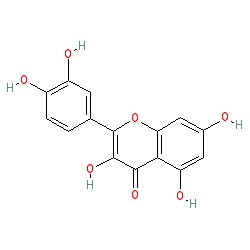GtoPdb is requesting financial support from commercial users. Please see our sustainability page for more information.
|
Compound class:
Natural product
Comment: Quercetin is a plant flavonoid. It is used as an ingredient in dietary supplements, beverages, and foods, and has been investigated for potential anti-inflammatory and senolytic-like actions.
Ligand Activity Visualisation ChartsThese are box plot that provide a unique visualisation, summarising all the activity data for a ligand taken from ChEMBL and GtoPdb across multiple targets and species. Click on a plot to see the median, interquartile range, low and high data points. A value of zero indicates that no data are available. A separate chart is created for each target, and where possible the algorithm tries to merge ChEMBL and GtoPdb targets by matching them on name and UniProt accession, for each available species. However, please note that inconsistency in naming of targets may lead to data for the same target being reported across multiple charts. ✖ |
|
|||||||||||||||||||||||||||||||||||
| No information available. |
Summary of Clinical Use  |
| Quercetin has been included alongside dasatinib in clinical trials to evaluate efficacy as senolytic therapy to modulate progression of Alzheimer's disease [5]. |
| Clinical Trials | |||||
| Clinical Trial ID | Title | Type | Source | Comment | References |
| NCT04685590 | Senolytic Therapy to Modulate the Progression of Alzheimer's Disease (SToMP-AD) Study | Phase 2 Interventional | Wake Forest University Health Sciences | ||
| NCT05422885 | Safety and Feasibility of Dasatinib and Quercetin in Adults at Risk for Alzheimer's Disease | Phase 1/Phase 2 Interventional | Hebrew SeniorLife | ||
| NCT04063124 | Senolytic Therapy to Modulate Progression of Alzheimer's Disease | Phase 1/Phase 2 Interventional | The University of Texas Health Science Center at San Antonio | 3-4 | |






